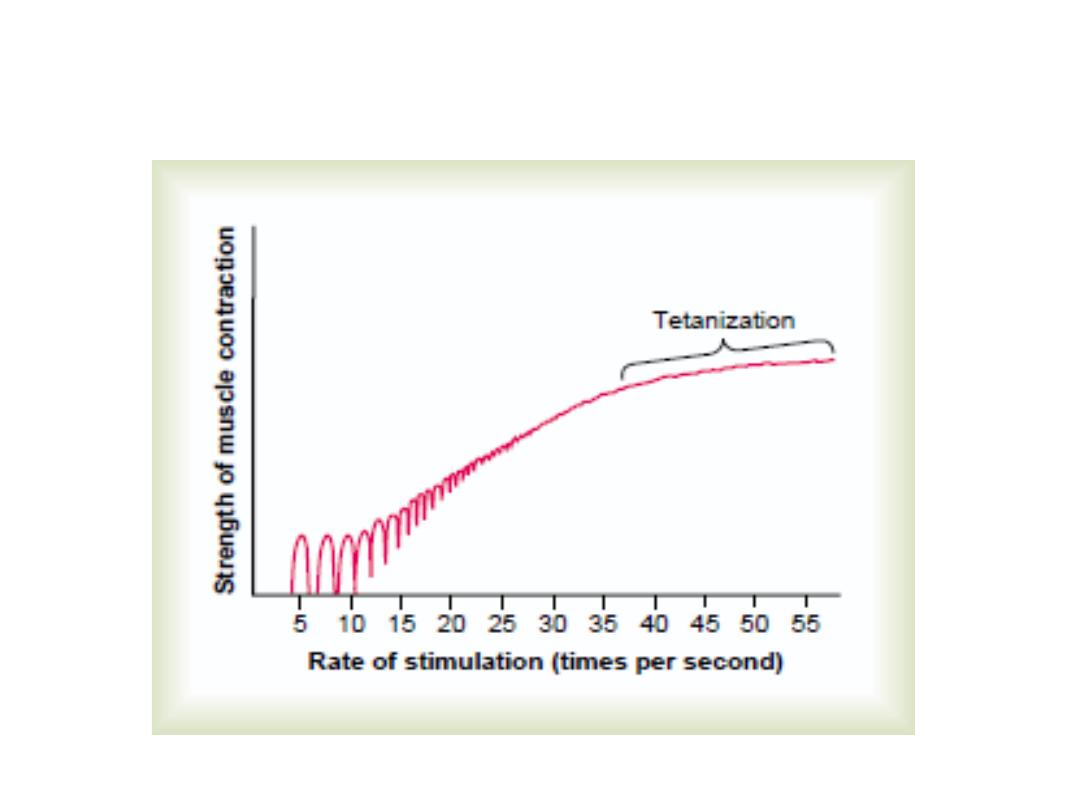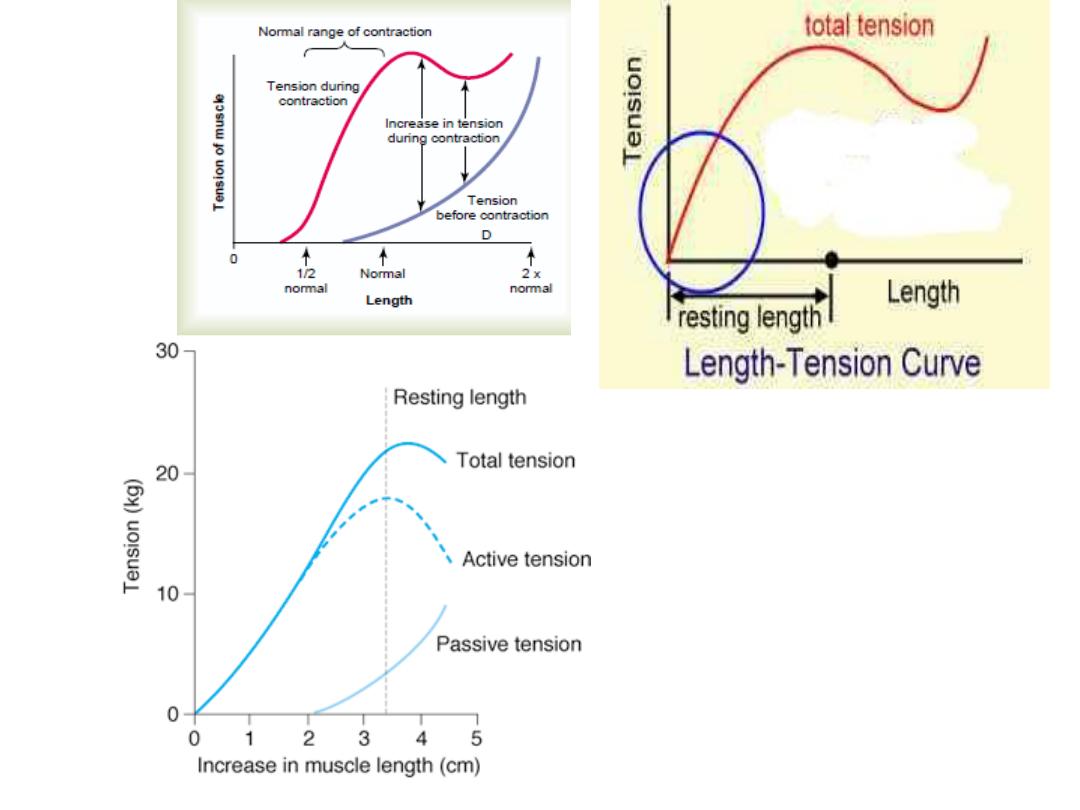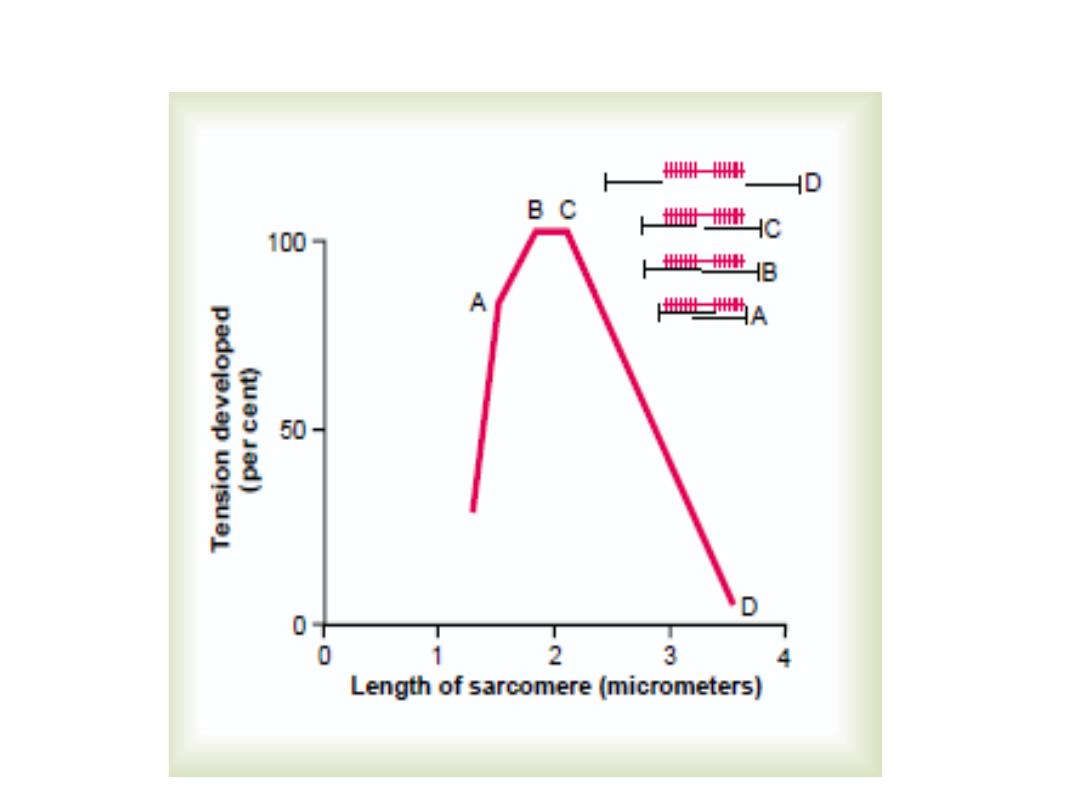
The muscle

Objectives
1-Recognize the meaning of summation of contraction
and its types.
2-detrmine the effect of changing length on skeletal
muscle tension.
3-Differntiate between the 2 types of muscle fibers.
4- Describe the motor unit and how its type affects the
function of the muscle?
5- Discuss the energy sources for the muscle and for
what it is used?
6-Outline the abnormalities in muscle fiber contractions

The summation of contraction
It means the adding together of individual twitch
contractions to increase the intensity of overall
contraction.
Because the contractile mechanism has no
refractory period.
Repeated stimulation, before relaxation can
produce additional activation of the contractile
elements .
The response will be added to that already present,
this is called
"summation of contraction".

It depends on the frequency of stimulation. It occurs in
2 ways:
1 – Multiple fiber summation (increasing the
number of motor units contracting at the
same time).
2- Frequency summation and tetanization, with
rapid repeated stimulation, before any
relaxation occurs and the response fuses into
one continuous contraction and the whole
contraction appears to be smooth called
Tetanus (
by increasing the frequency of
contraction).

During tetanus the tension developed is 4 times than
the individual contraction.

At slightly higher frequencies, the strength of the
muscle contraction reaches maximum, so any
additional increase in frequency beyond that
point has no further effect in increasing the force
of contraction,
This is because enough Ca ions are maintained in
the sarcoplasm ,even between action potentials
so will not allow relaxation to happen.
But if a lower frequency is used, there will be a
period of incomplete relaxation between the
summated stimuli; this condition is called
incomplete tetanization or clonus.

3- The CNS sends weak signals, so smaller motor
units contract than the larger ones, the
strength will increase, larger and larger motor
units will be excited (large motor units have
more contractile force than the smaller ones).

Effect of muscle length on the force of
contraction:
The tension develops in a muscle when it is
stimulated to contract
isometrically
; this is
called the total tension.
When the length of the unstimulated muscle
fiber is changed this is called passive tension..

Passive tension curve
is the curve plotted to
include the changes in tension against the
changes in the muscle length. It shows that, as
the length increases, it rises sharply.
The total tension curve
shows the total tension
against the passive tension, we will see a sharp
increase up to a maximum value, then the curve
declines.
If we measure the distance between the two curves
we will see
the active tension curve
which is
similar in shape with the total tension curve but
has a lower peak.


From these curves we will see that the maximum tension
occurs when the muscle length is at its resting length i.e.
the sarcomere length is about 2 micrometer (relaxed state).
Shortening or contraction of the muscle will reduce this
tension. This is because the maximum number of
interaction between actin and myosin occurs at the resting
length .So shortening of the muscle fiber, causes smaller
sarcomere and actin filament overlap, so less actin to
myosin interaction sites
Stretching of muscle fiber (increase in its length) will cause
less actin to myosin interaction i.e. bigger sarcomere with a
large gap in the middle ..


Energy sources and metabolism:
Contraction of the muscle depends on energy supplied by ATP.
In general the source of energy is the metabolism of
carbohydrates and lipids.
Most of the energy is required for physical activity
(contraction, relaxation) or walk along mechanism, and
small amounts are required for:
1- Pumping of Ca ions from the sarcoplasm to the
sarcoplasmic reticulum after the contraction is over.
2- Regeneration of ATP.
ATP split to ADP, then ADP rephosphorlated to ATP.
3- Removal of lactic acid.
4- Heat production.

Sources of energy for the rephosphorlation
:
1- Substance called phosphocreatine (high
energy phosphate bond).
ADP+P→ATP
This compound supplies energy to the muscle
at rest .During exercise this compound
hydrolyse at the junction between actin and
myosin releasing energy ,this reaction is
catalyzed by the enzyme phosphorylcreatinine
at the mitochondria and myosin heads.

2-
Glucose
: it is supplied by the blood and undergoes
series of reactions forming finally Co2, H2o and Energy.
3-
Glycolysis of glycogen
stored in the muscle cells:
enzymatic break down of glycogen to pyruvic which
has 2 pathways in the presence of O2, it enters citric
acid cycle (crips cycle), then the respiratory chain to
form co2, H2O and large amount of energy, (aerobic
Glycolysis). But in the absence of O2(like in prolong
contraction), pyruvate is reduced to lactate and lactic
acid and small amount of energy.
4-
The free fatty acids(FFA
) (gives double the energy that
glucose gives)
skeletal muscles take the FFA in the blood and oxidized
to give Co2, H2o and ATP (the use of FFA mainly at rest
and during recovery after contraction

The oxygen debt mechanism:
During exercise
the blood vessels dilates to provide
enough O 2 for the muscle, the energy is supplied by
aerobic glycolysis.
If the exercise is sever
or continues for longer
periods,
the anaerobic glycolysis
contribute
also to provide energy.
It is self limiting ,because lactic acid will diffuse
to the blood it will lower the PH ,accumulate
in the muscle causing muscle exhaustion ,

So after the exercise there will be a period of
hyperventilation to produce the extra amount
of O2 in order to remove the lactic acid and to
rebuild the storage of ATP and
phosphorylcreatinin . This extra amount of O2
taken to replace the demand required more
than that supplied by the aerobic glycolysis
during exercise is called the
oxygen debt
.mechanism

Trained persons need less period of
hyperventilation because they have
smaller
oxygen debt mechanism
(i.e. he has
endurance, he can use the muscle to perform
the job better).

Heat production in the muscle:
This is produced as:
1-
Resting heat
: liberated during resting stage.
2-
Initial heat
which is produced during activity and it is
divided into:
a-
Activation heat
: produced during contraction, from the
actin –myosin interaction.
b -
Shortening heat
: produced during shortening
(isotonic contraction), due to the changes in muscle
fiber structure during shortening.
In isotonic contraction there are both activation and
shortening heat but in isometric there is only activation
heat.

3- Recovery heat
: liberated by the metabolic
processes that restore the muscle fiber to its
precontraction state and it is rather equal to
the initial heat.
4- Relaxation heat
: liberated because work
should be done to return the muscle to its
original length (after isotonic contraction) in
addition to the recovery heat.

Types of muscle fibers
3 types according to the differences in enzyme activity,
metabolism and contractile properties:
1- Type I fibers
: these are darker than other muscles
called
Red muscles
or the slow fibers, they response
slowly and have longer duration of action(resist
fatigue). They are specialized for long slow sustained
contraction, supplied by slow conducting fibers. e.g.
muscles in the back and in the lower limbs which are
used to maintain posture. They are small fibers, have
more extensive blood supply to supply high oxygen,
and high number of mitochondria and large number of
myoglobulin.

2-
Type II b:
called the white muscles or the fast fibers, they
are innervated by large mylinated fibers, they have short
duration of action(fatigue quickly) .So they are specialized
for fine skilled movement e.g. muscles of the hand and the
extra-ocular muscles. They are large fibers and have
extensive sarcoplasmic reticulum for rapid release of Ca
ions, large amounts of glycolytic enzymes for rapid release
of energy, they have less extensive blood supply and fewer
mitochondria and less myoglobulin.
3-
Type II a
: this is rare type in human, has properties similar
to type I, and other properties to type II.

The motor units
:
The motor unit means all the muscle fibers
innervated by a single nerve fiber .i.e. the axon of
a single motor neuron divides to supply many
muscle fibers. There are 2 types of motor units:
1- Small motor units
: contain 3-6 muscle fibers,
concerned with fine graded, precise movement,
like movements of the hand. They are Small
muscles that react rapidly and whose control
must be exact have more nerve fibers for fewer
muscle fibers (2-3 muscle fibers for each motor
unit, e.g. laryngeal muscles).

2-
large motor units
:contain usually 120-165
muscle fibers ,like muscles of the back ,for the
sustained form of activity. These are large
muscles that do not need fine control (e.g.
soleus muscle), may have several hundreds of
muscle fibers in the motor unit.
Each motor unit is of one type i.e. innervates
one type of muscle, but when a nerve to slow
muscle is cut and replaced by a nerve to fast
muscle ,the slow muscle after a period of time
becomes fast.

The muscle fibers in each motor unit overlap
other motor units in microbundles of 3-15
fibers. This interdigitation allows the separate
motor units o contract in support of one
another rather than as individual segment.

Denervation:
Means the deprivation of muscles from the nerve supply, the following
effects will happen:
1- Immediate loss of muscular activity called flaccid paralysis.
2- Abnormal excitability of muscle fiber with increase sensitivity to
circulate Ach (deneravation hypersensitivity), this result in fine
irregular contraction of individual muscle fiber (fibrillation).
Up to these 2 points, if the nerve fiber regenerates these 2 effects
will disappear.
3- Atrophy of the muscle: prolong denervation results in degeneration
of the muscle fibers and replacement by fibrous tissue, this result in
reduction of muscle size called wasting (because of decay of
contractile proteins). If after 2 months the nerve supply back, full
return of function ,but after 3 months the return back of muscle
function is less, and after 1-2 years, no return of muscle function.
All these features are of lower motor neuron lesions which is the
effect from the spinal cord to the muscle. Above that is called upper
motor neuron lesion.

Contracture:
This is persistent sustained contraction of the muscle without an action potential,
causing no relaxation. It occurs due to the increase level of extracellular calcium.
Rigor:
When the muscle fiber is completely depleted of ATP and phosphoryl creatinin, they
develop a state of complete contraction causing increase rigidity after death
because no ATP available for relaxation ,in this state Rigor mortis ,almost all the
myosin heads attached to the actin in an abnormal fixed and resistant way.(it
occurs more rapidly in high temperature).
Muscle fatigue:
Prolonged and strong muscle contraction lead to muscle fatigue. This results from:
-Depletion of glycogen stores in the muscle (inability of the contractile and metabolic
processes to continue supplying the same work).
-Diminished transmission in the NMJ .
- Interruption of blood supply or flow results in nutrient and O2 deficiency.
